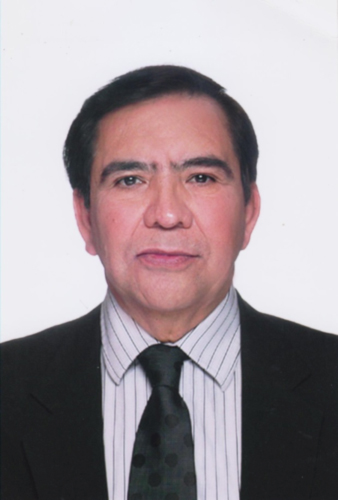Memoir - Manuel Soriano-García (1947 - )
Memoir | Publications | Curriculum Vitae | Videos | Slides | Articles | Obituary
ACA Living History2017 |
| Manuel Soriano-García was educated in Mexico and received his Ph.D. in biophysics under the direction of Rengachary Parthasarathy at SUNY Buffalo. As Research Professor at the National Autonomous University of México he established small-molecule and protein crystallography in Mexico, receiving many national awards. He studied the proteins of the amaranth plant, the rubber plant, and the anti-inflammatory properties of organoselenium compounds. |
I was born in Mexico City, on October 9, 1947. I was the third of four boys. My father was a railroad man and my mother was a housewife. Both of them had only three years of elementary school education because at that time the elementary school offered only up to the 3rd year which was enough to read and write in Spanish. My father was more interested in my older brothers and he was very hard on them. So, by the time I arrived he was tired and disappointed that my brothers were so bad in school. My two older brothers only finished elementary school and high school, respectively. For that reason, my father did not force me to study and I was left alone to go through school the best I could. In that way my parents did not know in what grade I was in until I graduated from college. Then my father was surprised but not pleased that I had gotten so far without any help.
When I finished High School, I had to decide which bachelor degree to take. I looked into different schools and was impressed by the title “Biochemical Engineer”. I liked chemistry and engineering and I felt that this would fulfill my goals at that time. I enrolled in the biochemical engineering degree at the National School of Biological Sciences at the National Polytechnic Institute (IPN). At that time IPN was the only schools for students of low income families.
I also had to enlist in the military service, which was mandatory. In just one year of military service I earned the degree of second lieutenant. I had the opportunity to continue my stay in the army but decided against it. I was already in the second year of the biochemical engineering school and I did not want to feel like I had wasted two years of my life. With that in mind I continued my studies.
During my college years I had a very busy schedule. I used to be a truck driver, a middle school teacher and a college student, at the same time. My whole day started at three in the morning and finished at nine at night from Monday to Friday. Saturdays and Sundays I was either sleeping or studying.
During my third year of college, I joined Professors Manuel Castañeda and Luz Maria Del Castillo´s research group. I worked in their laboratory for three years and they encouraged me to enroll in the Biophysical Sciences Department at SUNY at Buffalo to learn Crystallography. My Professors gave me some publications regarding crystallography, to get me interested. It seemed to be a very exciting field.
I did not know how to speak English and I only knew how to translate using a dictionary. I took the TOEFL and I passed. For me it was a very simple exam because it was based on multiple choices and I was very good at multiple choice tests.
Anyway, I arrived at Buffalo, on Labor Day in 1971. I got in contact with Prof. Robert Spangler, Department Head of the Biophysical Sciences Department, at SUNY-Buffalo. I stayed with him for several days until I was able to rent a room with Mr. Richard Perugini. He had me speak to him in English every day in order to improve my vocabulary and pronunciation. He corrected my language and with his help I was able to learn enough English to pass the critical courses in biophysics. His help will be always appreciated.
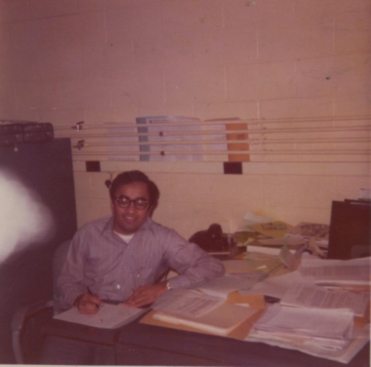
Professor Rengachary Parthasarathy, my mentor.
At the start of my second year, I spoke to Prof. Rengachary Parthasarathy about carrying out my research work on crystallography under his supervision and he accepted me. During this time I met Prof. S. Narasinga Rao, who was writing his Ph.D. thesis. Dr. Rao helped me to understand the basic crystallography principles, which would be essential to successfully carry out my research. Unfortunately, a few months later he left the laboratory and moved to Oklahoma. We are still good friends.
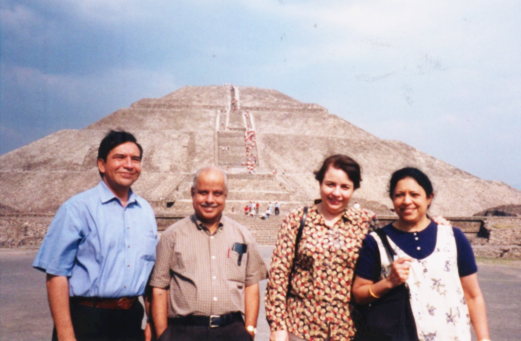
Manuel Soriano-García, S. Narasinga Rao, Cynthia Lesh and Mrs. Narasinga Rao, standing in front of the Pyramid of the Sun (1998).
During the summer of 1973, I did my summer research on the crystal structures of several metal alkaline derivatives of malonic acid in order to understand the effect of these metals on their intermolecular hydrogen bonds of malonic acid. My research was approved and I became a Ph.D. candidate.
In September 24, 1973, I was introduced to Miss Cynthia Lesh and immediately we got along very well. We were engaged a week later and by May 30, 1975 we got married at City Hall in Downtown Buffalo, in a very simple ceremony. In November 1975 my son Simon Manuel was born at Children’s Hospital in Buffalo. He is now a mechanical engineer.
I worked very hard and I solved several crystal structures of some modified nucleosides of tRNA and several plant hormones, which at that time were very hot topics. In May of 1975, I concluded my Ph.D. research and I was ready to finish my Ph.D. degree. Prof. Parthasarathy asked me if I wanted to do some extra work on anomalous dispersion. I agreed and I did it.
I took all of Prof. David Harker's courses; he was Department Head of the Biophysics Department at Roswell Park Memorial Institute. At the end of each course he would give an exam to solve. I always received an INCOMPLETE. I had to give a talk and a written report every week which covered the course topics. This was a nightmare; I was the only student that had to do this. Because of that, I learned a great deal and in great detail the topics that were given.
During the 1970s and early 1980s many crystallographers were working on the subject of developing the direct methods procedures to solve the three dimensional crystal structure of small molecules and proteins. These methods make use of relationships between the intensities of the various reflections which lead directly to a solution of the crystallographic phase problem. I was very lucky as a graduate student to experience the development of these procedures and received lectures from Professors Herbert Hauptman, Jerome Karle, Isabella Karle, Peter Main, Henk Schenk, George Michael Sheldrick, and Carmelo Giacovazzo amongst others.
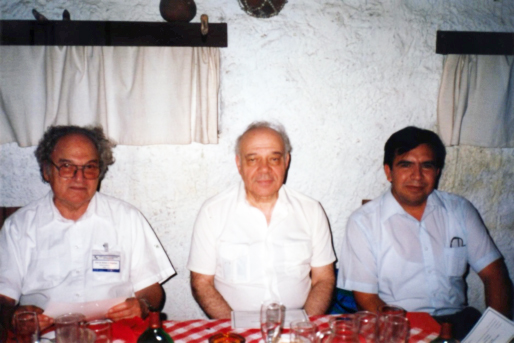
Herbert A. Hauptman, Jerome Karle and Manuel Soriano-García (1994).
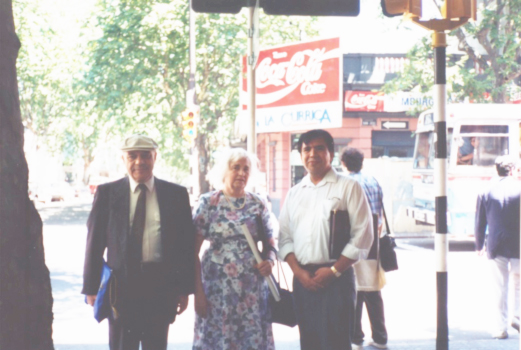
Jerome Karle, Isabella Karle and Manuel Soriano-García (1994).
After I received my Ph.D. degree, Prof. David Harker explained why he gave me the incompletes. He said: “When you leave this laboratory and return to Mexico you will not find anyone to help you and you will have to solve the problems by yourself”. Since I was the only crystallographer in Mexico, I really did not have anyone to run to when I needed help. So, Prof. Harker was right.
The National Research Council of Mexico gave me four years to get my Ph.D. I was really rushed. I did it in three and a half years to the amazement of everyone.
I presented my Ph.D. exam on November 5, 1975. I was very lucky to have on my dissertation committee: Profs. David Harker, Gopinath Kartha, Herbert Hauptman, Robert Rain and Rengachary Parthasarathy.
In December 1975 I left Buffalo with my Ph.D. degree in hand, a wife and a son all-in-one package. Upon returning to Mexico, my aim was to establish Crystallography. Great hopes and no job! On January 26, 1977 my daughter Michelle Ann was born.
By mid-1977, I had been in the country now for more than a year and I had a difficult time. Nobody knew about crystallography and, since I came from a poor family, I did not get much help. Now if I were rich, or came from an influential family, then doors would have been opened faster.
One day I met an old classmate, Prof. Erasmo Flores-Valverde, and he was the one that helped me get a job at the Chemistry Department, Metropolitan Autonomous University-Iztapalapa Unit (UAM-I).
I worked at UAM-I for five years teaching General Chemistry, Physical Chemistry and Biochemistry courses. While at UAM-I, I was able to raise just enough funds to buy the first automated diffractometer but because of monetary exchange rates and devaluation I was not able to purchase the instrument.
While I was working at UAM-I, I used my summer vacations to work with Dr. R. Parthasarathy on some of his projects. He provided me with the financial support that I needed. During this time I collected data for some of my crystals that I had grown in Mexico.
In May 1982 the Chemistry Institute at National Autonomous University of Mexico (UNAM) purchased an automatic X-ray diffractometer. The interesting thing was that they had the machine but no one knew how to use it. That’s where my luck changed! I was asked to come and train two technicians and, if I really needed it, I could ask for some time on the machine. I replied that if they gave me a permanent position, then I would teach them. They agreed and I was hired as a researcher at UNAM. I was finally a research scientist in Olympus. That is what the Chemistry Institute was called because it was so hard to get in. I was the first researcher to be admitted that came from the IPN.
During the following five years I solved many different crystal structures from natural products, intermediates of chemical synthesis, organometallics, inorganic compounds, amongst others. I trained two technicians; they did all the data collection and solved the crystal structures under my guidance.
In June of 1985, I organized the "1st Seminar of X-ray Crystallography on Small Molecules in Mexico”. The idea behind this was to promote the impact of small molecule crystallography in the fields of Chemistry, Physics and Biochemistry in Mexico.
In April of 1988, I organized the "X Congress of the Latin American Group of Crystallography" at the Chemistry Institute, UNAM. The purpose of this academic event was to welcome the Spanish Community Crystallographers to Mexico. People from Spain, Colombia, Venezuela, Brazil, Argentina, Chile, Uruguay and the United States attended and presented their work.
In 1990, I received the National Award in Chemistry in Mexico from the Mexican Chemical Society due to my contributions on the crystal structure determinations of small molecules. This work helped many Mexican scientists with their research goals. My first scientific goal was achieved: to establish Small Molecule Crystallography in Mexico.
My next goal was to establish Protein Crystallography in Mexico. In May of 1985, we got the first protein crystals at our laboratory. We presented our results during the First International Conference on Protein Crystal Growth, Stanford University (1985).
My very first problem was: I had protein crystals but the detector that I had was unsuitable for protein data collection. Fortunately during an ACA meeting I met Prof. Alexander Tulinsky and I told him about my detector problem. He said that he had the same X-ray diffractometer with a long arm detector for protein data collection and his group had developed the new software for protein data collection. I asked him if my group could have a copy of his software. He agreed to give me a copy, but suggested that I should visit his laboratory at Michigan State University, to get hands-on experience using it. I spent three weeks at his laboratory and learn how to use this software and went back to Mexico with a copy of the software. During this time, I purchased the long arm detector that was missing.

Colleagues at Michigan State University. In front, K. Padmanabham and T. P. Seshadri;
standing and holding the baby, P. Padmanabham (1988).
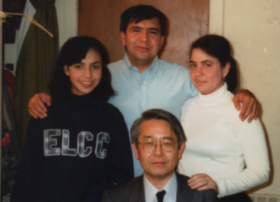
Michelle A. Soriano-Lesh, Manuel Soriano-García, Cynthia Lesh and Takao Matsusaki (Michigan State University, 1989).
In 1988, I spent my sabbatical leave with Prof. Alexander Tulinsky. I had a hard time in understanding the protein solution and refinement software, but fortunately K. G. Ravichandran, a graduate student of Dr. Tulinsky, helped me understand it. His help will be always appreciated. Dr. Tulinsky gave me a project to solve the structure of one of the blood coagulation cascade proteins. I was able to grow the crystals, collect data and to solve the structure.

Structure of Ca(2+)-Prothrombin Fragment 1, a protein of the blood coagulation cascade (PDB 2PF2).
During my sabbatical leave, I was able to collect data on the Hevein (a protein isolated from the rubber tree latex) crystals which had I brought with me from Mexico. This helped me solve the first protein structure in Latin America, with the help of only one graduate student.
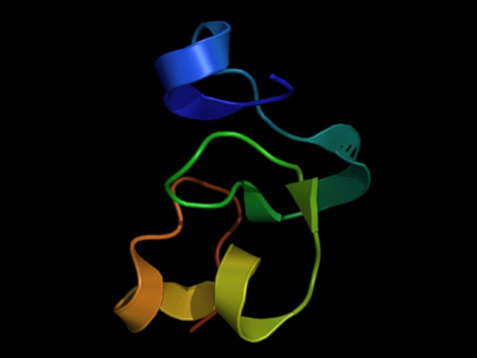
The structure of Hevein, a protein from the latex of Hevea brasiliensis (rubber tree); the first protein structure solved in Latin America.
In 1992, I received the National Award to the Best Faculty Member at IPN. In 1994, I received the National Award in Science from the National Academy of Sciences of Cuba for my outstanding contribution to Small Molecules Crystallography.
Upon returning to Mexico, eight graduate students from Mexico and two postdocs from India contacted me. They wanted to work on the isolation, purification, the biochemical and spectroscopic characterization of plant proteins.
In 1993, was the year to organize a series of conferences to introduce Structural Biology in Mexico. Well known professors from the United States were invited, their names are: David Davies, Johann Deisenhofer, James M. Hogle, Paul Sigler and Gerhard Wagner. The academic program was sponsored by the U.S. National Academy of Sciences, USA.

Manuel Soriono-García (standing), William Duax (standing), Johann Deisenhofer (seated),
and graduate students at the Chemistry Institute, UNAM (1994).
In 1994, I organized the "First School of Protein Crystallography in Mexico" at UNAM. This school was sponsored by the U.S. National Academy of Sciences and is offered yearly at the Cold Spring Harbor Laboratory, Brookhaven National Laboratory Cold Spring Harbor, NY. This time, it was offered in my laboratory at UNAM. There were a total of twenty participants.
Because of this course, I received a grant and I was able to purchase an automatic X-ray diffractometer from Rigaku. It was equipped with an imaging plate that allowed me to create an experimental area for the isolation, purification and crystallization of plant proteins. That was really very good.
In 1997, not all is happiness! I had serious problems with the Director of the Chemistry Institute (UNAM) to the extent that all my research facilities were taken from me. After the Christmas Vacation, upon returning to work, I found myself with no office and no lab. They were reassigned to another researcher, who had been my graduate student. At that time I felt that all of my work of 12 years was for nothing and as a result of this situation I went into a deep depression. This led me to diabetes.
One good bit of news was that my daughter received a bachelor’s degree in biomedical sciences from UNAM; she went on to receive a Ph.D. in immunology from Harvard Medical School and currently works for a pharmaceutical company in Paris, France.
In 1999, because of my work on the isolation, purification, biochemical characterization and preliminarily crystallization studies of Amaranth globulin proteins I was awarded the National Award in Food Science and Technology from the National Council for Science and Technology (CONACyT) and the Mexican Coca-Cola Industry.
In 2000, I decide to visit my crystallographer friends and I spent five months (October 2000 to February 2001) working at the Consejo Superior de Investigaciones Cientificas (CSIC) of Spain in Barcelona. While I was there I helped to solve the structure of a Catalase isolated from Pseudomonas syringue, under the supervision of Prof. Ignacio Fita.
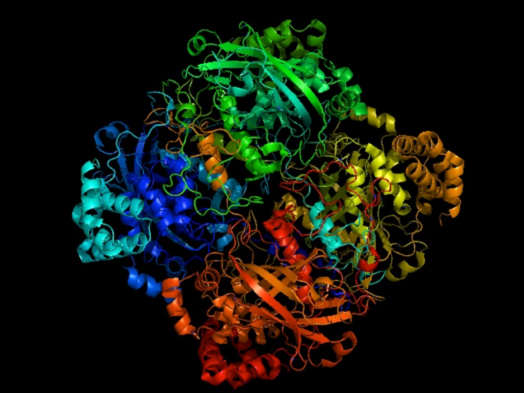
Structure of a Catalase isolated from Pseudomonas syringue (PDB 1M7S).
At that time, I realized how crystallography changes. Starting from small molecules, to large proteins, such as the catalase, I realized that there is much more to learn.
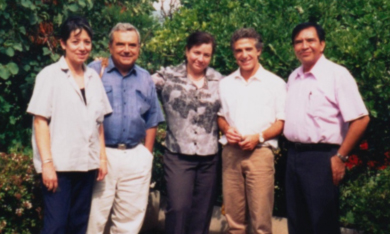
Barcelona Crystallographic Group (2000). Lourdes Campos, Juan Antonio Subirana,
Cynthia Lesh, Ignacio Fita and Manuel Soriano-García (2000).
During my stay in Barcelona and Valencia, my wife and I made good friends with other crystallographers: Ignacio Fita, Juan Antonio Subirana, Lourdes Campos; Juan José Calvete, and Libia Sanz. Our friendship continues to this day.
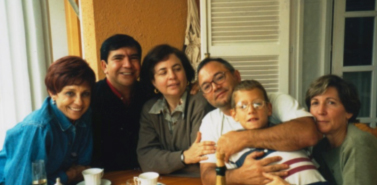
Manuel Soriano-García, Cynthia Lesh, Juan José Calvete and Libia Santz (2000).
When I returned to Mexico in March 2001, things had not gotten any better at work. I had to share a laboratory with another researcher working under difficult conditions with no financial support and no equipment.
So, I called upon an old friend from my days in Buffalo, Professor Takao Matsusaki. I asked him if he knew of any professor that could use my help. Professor Matsusaki introduced me to Professor Hideaki Moriyama, who invited me to work with him and I agreed. I spent 4 months (August to November, 2001) as an Invited Research Professor at the Japan Synchrotron Radiation Research Institute (JASRI/SPring-8) Japan.
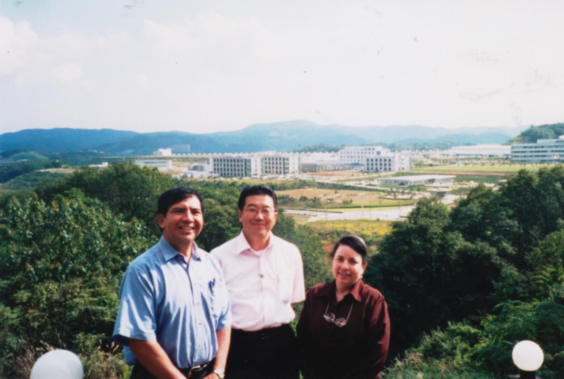
The Japan Synchrotron Radiation Research Institute (JASRI/SPring-8).
Manuel Soriano-García, Hideaki Moriyama and Cynthia Lesh (2001).
During my stay I helped crystallize some proteins which were of special interest to Prof. Moriyama. While I was there I was also able to obtain protein crystals of a globulin protein isolated from Amaranth seeds.
I was invited in February 2004 to give a lecture to a group of Amaranth farmers. I gave my talk as simply as possible. The farmers came and thanked me for the talk. One was quite frank, and in front of several people he said. “Doctor we did not understand your talk. You had beautiful slides with beautiful colors. The real questions are: What did it all mean? What can we, as Amaranth farmers, do with this information?” These questions made me realize that I could use my knowledge with proteins and crystallography to develop a product that would use the Amaranth seed. This product could have great potential.
In 2004, my graduate student crystallized an ancient proteolytic enzyme called Mexicain. During the Aztec Empire it was used it as a meat tenderizer. I solved the crystal structure and the action mechanism of this enzyme was elucidated using X-ray crystallography.
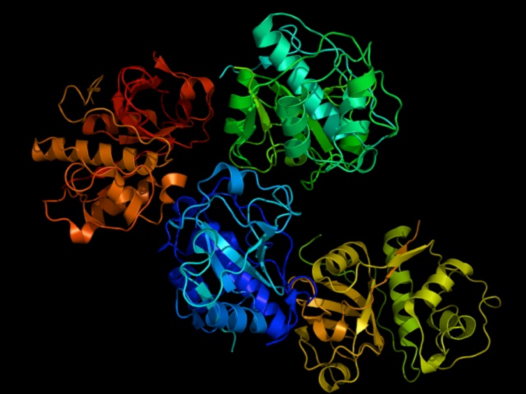
An ancient proteolytic enzyme called Mexicain.
This enzyme was used as a meat tenderizer during the Aztec Empire in Mexico (PDB 2BDZ).
In 2004 I also started having terrible pains and swelling in the joints of two fingers in my right hand and the pain continued for several months. I decided to go to the doctor and he prescribed an analgesic. Not pleased with this prescription, I returned to my laboratory and decided to investigate this problem. I found that selenium and gold were used to alleviate pain and swelling in the joints. A few days later I received an invitation to write a review in the Journal of Medicinal Chemistry. I immediately replied to the editor and the title of the review was “Organoselenium Compounds as Potential Therapeutic and Chemopreventive Agents: A Review”.
Several organoselenium compounds were prepared and the anti-inflammatory activity was tested on Wistar rats. The results were satisfactory. I made a cream with one of these compounds and put some of it on my affected joints. Lo and behold, the pain and swelling disappeared. I solved the problem of pain and swelling of the joints.
The more I use crystallography, the more applications I find. I believe so much in this that I asked my wife and son about starting a company together. I knew it would be hard but thought it was worth a try. We named the company Gastronomía Molecular S. A. (Molecular Gastronomy). This name came from Gastronomía which is related to nutrition and Molecular related to crystallography. I have so many ideas going on in my head all the time that this would be the best way to try them out. At the present time my son Simon is the CEO of this company.
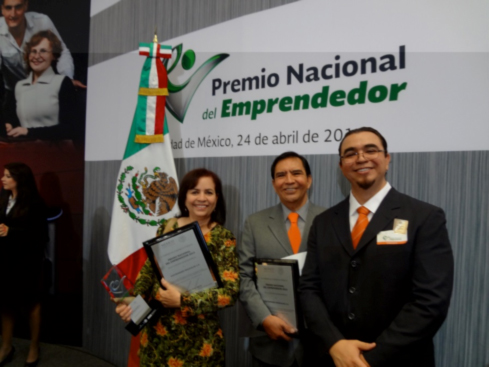
Founders of Gastronomía Molecular S. A. Cynthia Lesh, Manuel Soriano-García and Simon M. Soriano-Lesh,
accepting the National Awards in Productivity and Entrepreneurship,
2014 presented by the National Institute Entrepreneurship and Ministry of Economy of Mexico.
Because I did not have any backing, either from the University for my research or from private sources, I did not know what to do. That is where Dr. Alejandro Rodriguez from the Tecsiquim SA de CV came to my rescue. He helped me to produce my products at the industrial level. I wish to thank him for his generosity and friendship that he has helped me through thick and thin.
For the last several years I have been invited to give many interviews on the radio, TV, magazines, and newspapers. I received four national awards for the work I have done. The first was the National City Award in Innovations “Heberto Castillo, Engineer”, in 2012. The next ones were the National Award in Productivity and the National Entrepreneur Award both in 2014. These were given by the Economics Secretary in Mexico. The last one was the National Award in Health 2014 given by Confederation of Employers of the Mexican Republic (COPARMEX). All these awards were given due to innovations, high quality and performance of my products.
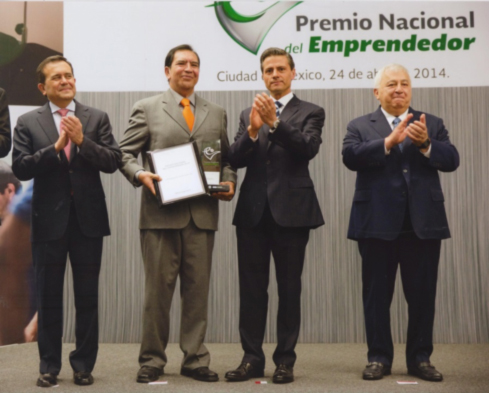
National Awards in Productivity and Entrepreneurship, 2014. Lidelfonso Guajardo, Economy Secretary;
Manuel Soriano-García, Enrique Peña-Nieto, President of Mexico, Emilio Chuayffet, Education Secretary.
I continued working with several small proteins isolated from the Amaranth seeds called Non-specific Lipid Transfer Proteins (LTP) in plants and some others small proteins with great antibacterial and antifungal activities.
Now, do not forget I am doing all of this while I am still working at the Chemistry Institute during the day. During the afternoon and evening hours I work at our company.
I should mention that all my work has been done at UNAM and I never left my working position in Mexico even under very difficult working conditions with limited funds and no support to attend any academic event. When I attended any academic event inside or outside of Mexico, I had to pay for all my expenses such as registration, airplane tickets, hotel and food.
Since 1973 when I started working in the field of crystallography, my research productivity has been to publish 265 research papers in different national and international journals, to guide 10 undergraduate students, 16 with a Master in Science degree and 14 Ph.D. students, seven patents, and many presentation of my work at different academic events.
My solid academic background and extensive experience in the work of basic research, as well as my particular vocation, passion for science and endearing identity by the natural resources of Mexico, have allowed me to consolidate important technological developments for the benefit of a broad sector of the population in national priority emergency areas such as food and health.
Because I have always had such an active and inquisitive mind, crystallography has helped me to work in so many different fields from basic to applied science. I think my best work as a scientist was to work on the practical applications of crystallography to develop several innovative products that have helped thousands of people. I am very satisfied with my work.
I would to thank crystallography for magnifying my horizons.

